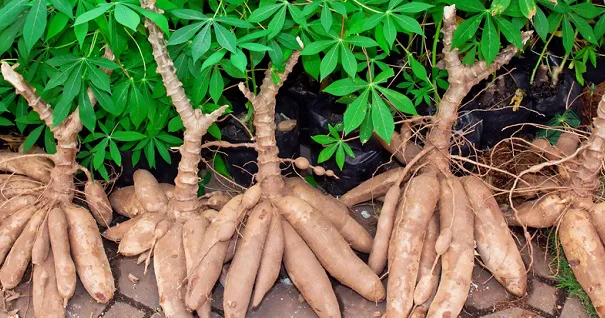Most people view food as a source of comfort, nourishment, and tradition. Yet, beneath the surface of the global diet lies a hidden danger — a handful of everyday foods that can quietly turn deadly when prepared the wrong way.
Health experts say that every year, hundreds of lives are lost not to exotic diseases or rare toxins, but to ingredients found in home kitchens. What makes these foods so treacherous is not their rarity but their duality: the same traits that make them sustaining can also make them lethal.
One of the most striking examples comes from a root that feeds nearly a tenth of the world’s population — a crop that has sustained communities for generations, while quietly taking hundreds of lives each year.
A Deadly Staple Hidden in Plain Sight
In rural Africa, Latin America, and parts of Southeast Asia, a starchy plant called cassava — also known as yuca or manioc — forms the foundation of millions of daily meals. To the eye, it looks harmless: a simple brown tuber, often fried, boiled, or mashed. But inside its fibers lies a chemical defense system that, if mishandled, can turn a meal into a poison.
Cassava naturally contains cyanogenic glycosides, compounds that release cyanide when metabolized in the human body. Eaten raw or prepared incorrectly, cassava can cause severe poisoning — dizziness, headaches, difficulty breathing, paralysis, and even death.
The World Health Organization estimates that roughly 200 people die each year from cassava poisoning, making it the world’s deadliest commonly eaten food.
Yet despite the danger, cassava remains indispensable. It thrives in poor soil, requires little water, and sustains over 800 million people across 80 countries. For many families, it’s not a choice but a necessity — a lifeline in regions where few other crops can grow.
Traditional preparation methods — peeling, soaking, fermenting, drying, or boiling — neutralize the toxin, making cassava completely safe. Generations have passed down these techniques, transforming a potentially deadly root into a daily source of survival.
Fugu: Japan’s Ultimate Culinary Gamble
While cassava represents survival, another food embodies deliberate risk. In Japan, fugu, or pufferfish, has achieved near-mythic status. Served in high-end restaurants, it’s prized for its delicate flavor — and for the danger it presents.
The pufferfish’s organs contain tetrodotoxin, a neurotoxin up to 200 times more lethal than cyanide. Even the smallest misstep in preparation can be fatal. Victims of poisoning often remain conscious as paralysis sets in, unable to move or speak before respiratory failure takes hold.
Japan records around 50 fugu-related poisonings annually, most caused by unlicensed cooks or home preparation attempts. To protect the public, Japan enforces some of the strictest food regulations in the world. Only chefs with years of rigorous training and certification are allowed to prepare fugu.
Despite the risk, diners continue to seek it out — not just for its flavor but for the thrill. For many, fugu represents the ultimate intersection of danger and precision, a cultural ritual where mastery triumphs over mortality.
When the Ordinary Turns Deadly
Not all food hazards are exotic. Some come from produce and pantry staples so familiar that few suspect their potential harm.
The starfruit, for instance, is celebrated for its bright flavor and striking shape. Yet for people with kidney disease, it can be deadly. The fruit contains neurotoxins that healthy kidneys can filter — but in those with renal impairment, these toxins accumulate, causing seizures, confusion, or death.
Even the seeds inside everyday fruits hide danger. Cherry pits and apple seeds contain amygdalin, a compound that converts into cyanide when chewed. While swallowing a seed whole is harmless, crushing or consuming large quantities can be toxic.
The Green Potato Warning
Few vegetables are as common as the potato, yet even this household staple can become hazardous. When exposed to light, potatoes produce chlorophyll, signaling the presence of solanine, a natural poison. In high concentrations, solanine can cause nausea, confusion, and even paralysis.
Experts advise discarding green or sprouted potatoes entirely — a simple act that can prevent rare but serious poisoning.
Hidden Dangers in Everyday Ingredients
Nature’s hazards extend beyond the vegetable patch. Raw cashews, for instance, contain urushiol — the same irritant found in poison ivy. True “raw” cashews are never sold commercially; the nuts are steam-treated to remove the toxin before packaging.
Similarly, the spice nutmeg, a holiday favorite, harbors myristicin, a compound that affects the nervous system. In small amounts, it’s harmless. But just two teaspoons can cause hallucinations, nausea, or seizures.
Meanwhile, wild mushrooms such as the death cap remain among the world’s most dangerous foods. Containing toxins that cause liver failure, they are nearly indistinguishable from edible species. Even expert foragers have died after a single mistake.
And in gardens and kitchens, another familiar plant hides its warning in plain sight: rhubarb. While its stalks are edible and tartly delicious, the leaves contain oxalic acid, a compound capable of causing kidney failure in high doses.
Finally, even a bowl of beans can turn deadly. Raw or undercooked kidney beans contain phytohaemagglutinin, a toxin that induces severe vomiting. Boiling beans for at least ten minutes destroys the compound, but slow-cooking or partial heating can intensify its toxicity.
A Lesson in Caution and Resilience
Taken together, these examples reveal a simple truth about human survival: the boundary between nourishment and poison is often thin — and knowledge is the key to safety.
From cassava farmers in West Africa to sushi chefs in Tokyo, people across cultures have learned to navigate this balance. They’ve developed traditions and techniques to make dangerous foods safe, turning potential threats into sources of strength and sustenance.
It’s a reminder that the kitchen, like nature itself, demands respect. The foods that sustain us can also harm us — and every meal, whether humble or exquisite, carries the quiet legacy of human adaptation and survival.
Handled wisely, these foods are a triumph of knowledge over risk. Handled carelessly, they serve as a stark reminder that even in the act of eating, the line between life and danger can be razor-thin.

Sarah Mitchell is a bestselling novelist recognized for her insightful and emotionally resonant stories that explore the complexities of human relationships. Originally from Denver, Colorado, Sarah grew up in a family of teachers who nurtured her curiosity and love for storytelling. She studied psychology at Stanford University, where she became fascinated by the intricacies of human behavior—an interest that would later shape her writing career. Sarah’s novels are praised for their nuanced characters, intricate plots, and ability to capture the subtle tensions that define love, friendship, and family ties. Her breakthrough novel, The Spaces Between Us, became an instant bestseller, lauded for its honest portrayal of strained family relationships and the fragile bonds that hold people together. Since then, she has published several works that continue to captivate audiences around the world. Outside of her writing career, Sarah is passionate about mental health advocacy and often partners with organizations to promote awareness and support for those struggling with emotional well-being. Her personal life is quieter—she enjoys hiking in the Colorado mountains, practicing yoga, and spending time with close friends. With each new book, Sarah Mitchell cements her reputation as a writer who illuminates the beauty and struggles of human connection.








